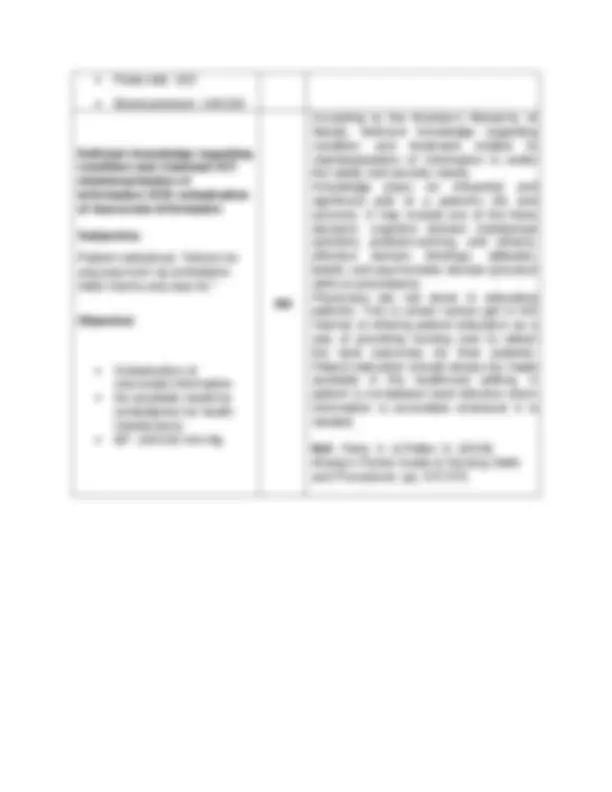



Study with the several resources on Docsity

Earn points by helping other students or get them with a premium plan


Prepare for your exams
Study with the several resources on Docsity

Earn points to download
Earn points by helping other students or get them with a premium plan
Community
Ask the community for help and clear up your study doubts
Discover the best universities in your country according to Docsity users
Free resources
Download our free guides on studying techniques, anxiety management strategies, and thesis advice from Docsity tutors
Problem Prioritization and Justification
Typology: Exercises
Uploaded on 04/08/2021
4.7
(7)5 documents
1 / 3

This page cannot be seen from the preview
Don't miss anything!


Problem Prioritization NURSING DIAGNOSIS & CUES
Chronic pain related to inflammatory process as evidenced by reports of pain and easy fatigability. Subjective: The patient verbalizes, “Sumasakit pag kumikirot” Objective: Guarding behavior Facial grimace while standing up Visible signs of inflammation in the affected area Pain scale of 7/ Vital signs: RR: 24 cycles per minute PR: 103 bpm BP: 140/ 1st This has been the prioritized problem according to the sequence of ABC, MAAUAR method, and Maslows. In the absence of airway, breathing, and cardiovascular function problems, the priority problem should be the pain based on MAAUAR paradigm which includes:
Mental status problem > Chronic Pain Acute impaired urinary elimination, Unresolved needs Abnormal diagnostic test result Risk In line with this, acute or chronic pain should also be addressed first as it causes changes in client’s homeostasis and cooperation on the procedure. Moreover, the nurse is also capable of addressing this concern with appropriate interventions. Ref: Brunner&Suddarth’s Textbook of Medical-Surgical Nursing, Volume 1, 13th Edition Establishing Priorities: NCLEX RN of Registered Nursing Organization. Ineffective breathing pattern related to diminished lung function as evidenced by tachypnea, dyspnea, and utilization of accessory muscles when breathing. The client verbalized that: that he was a smoker 6 years ago with 1 pack ( 2nd This has to be the second prioritized nursing diagnosis because of the following reasons: With aging, there is a decreased functioning of the respiratory system that may result to hypoxia and/or hypoxemia which can pose the client in more serious complications. An older client with ineffective breathing problem, who has a history of smoking can easily develop or acquire respiratory diseases due to the damage brought
cigarettes) a day “Kumpara nung bata ako, mas hirap na hirap ako huminga ngayon. Mabigat yung paghinga, siguro dahil sa paninigarilyo ko dati” Objective: Difficulty of breathing as evidenced by: Use of accessory muscle RR: 24 cycles per minute Nasal flaring PR: 103 bpm BP: 140/ about by prolonged use of nicotine products. The acquisition of these additional complications, such as viral or bacterial invasion, may further complicate his respiratory status. In addition, this risk, although not actual, poses a life threatening crisis on the patient as it involves the airway, which is number one on ABC model, and is also a problem on physiologic needs under Maslow’s hierarchy. Ref: Kozier et al. Fundamentals of Nursing. 9th Edition, 2002 Activity intolerance related to pain and weakness as evidenced by signs of fatigue, weakness, and abnormal discomfort during activity. Subjective: The patient stated that “hirap na hirap akong kumilos kasi sumasakit tuhod ko kahit kaunting galaw lang, saka nahahapo ako agad kapag naglalakad kasi para akong hinihingal.” Objective: (+) Increased RR during activity (RR: 24 when rested and 28 during slow walking) (+) Grimace when standing and walking Pain scale: 7/ Grade 3- Moderate Kellgren Lawrence Osteoartritis classification 3rd This has to be the third prioritized problem because of the following reasons:
Activity intolerance may lead to other independence-related crisis such as self- care deficit and other performance-based activities. Prolonged activity intolerance may lead to decreased functioning, which may result to muscle atrophy and ulcerations if not addressed immediately. Additionally, this is ranked third after the chronic pain and ineffective breathing because the resolution of the first two problems may lessen the severity or magnitude of this intolerance. Ref: Kozier et al. Fundamentals of Nursing. 9th Edition, 2002